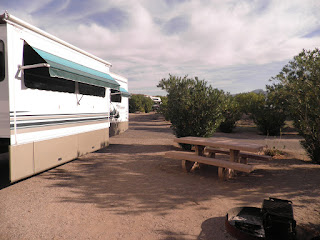We left Mittry Lake after our 10 day limit. On our way to I-8 we stopped at a local RV park to dump our grey and black tanks. Friends told us not to get water at the RV park as it wasn't very good. They said the rest area on I-8 before El Centro, California had great water and a good view of Imperial Dunes. Of course, we topped off the gas tanks in the RV and the car; we also filled our propane tank even though it wasn't down very much before leaving the Yuma area.
As we drove west on I-8, we began to see road construction. Oh, no! The rest area was closed! Now where would we find fresh water to fill our tank? Well, after looking at my map on the laptop, I suggested we go to the military base just west of El Centro. If nothing else, maybe we could fill our fresh water tank. After little discussion, we headed for El Centro NAF (naval auxiliary field), winter home of the Blue Angels.
We were able to get a campsite for the night and the Auto/Hobby Shop had a free car wash so the CRV is now clean (for a day anyway). We took the opportunity of having full hook-ups to have long, luxurious showers, to use the microwave, and to enjoy cable television! We hadn't had hook-ups for 39 days--since the RV park near Zion in Utah! We plan to continue not having hook-ups the remainder of our time in California.
The next morning we stowed our things and headed for the Salton Sea. It is the largest lake in California. Our first stop was Sonny Bono National Wildlife Refuge at the southern end of the lake. After looking around the visitor center we walked Rock Hill Trail to see Salton Sea. Near the end of the trail we saw an area with man-made islands. Salton Sea is saltier than the Pacific Ocean, but this pond has fresh water pumped in for nesting birds. The pond also has an electric fence around it to keep out predators.
In an effort to keep migrating birds out of farmers' fields, the refuge plants fields near the Salton Sea with crops especially for the birds. This seems to work because these were the only fields where we saw birds.
Rock Hill Trail is named for this hill leftover from volcanoes long ago. In fact, the trail had a lot of obsidian in it as we walked the refuge. The San Andreas Fault lies under the Salton Sea.
There was a nice view of Salton Sea from Rock Hill at the end of the trail.
From the refuge, we traveled north to Salton Sea State Recreation Area. We found a campsite at Rock Creek Beach. There were only 2 other campers at the beach.
One thing you notice when you first arrive at Salton Sea is the smell. The water is too salty for most fish. Tilapia were brought in to stock the lake and they have thrived. In fact, they are the only fish living in the sea. The beach is covered with fish carcasses.
This white pelican was enjoying the end of the day floating near our campsite as we enjoyed the sunset.
Friday morning we decided to geocache--are you surprised? Our goal is to have 4000 by the time we get home. One geocache was supposed to be located at this deserted homestead. The water tower is from a WWII airplane. We searched and searched, but could not find the cache.
Of course, when you are near Niland, California, you have to visit Slab City. In 1942 it began as a Marine Corps training camp. By the early 1960s, all the buildings had been sold and moved so that only the slabs were left. That is when an eclectic group began moving into the area. One resident, Leonard Knight, began building Salvation Mountain at the entrance to Slab City.
Leonard Knight worked on this mountain for over 20 years before his recent death . Volunteers continue his work today.
After passing Salvation Mountain, you can see all sorts of camping rigs. This was one that caught our attention.The area is definitely interesting.
Tomorrow we will move on to Joshua Tree National Park.
For those interested in our budget, even after buying a new tire ($200), eating out, and sightseeing, we are averaging $62.59 a day.



















































